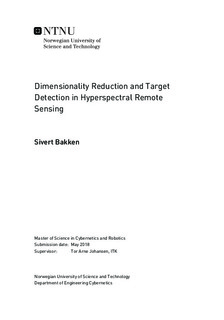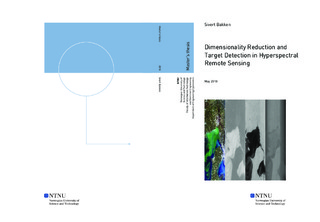| dc.description.abstract | The work presented here is originally motivated by the low transfer rate possible for earth orbiting small satellites.
Through different methods for dimensionality reduction, the effects of such representation on data exploration with respect to target detection have been investigated.
The theory suggests that through using these methods for dimensionality reduction a considerable compression ratio could be achieved whiteout losing desired information.
How these reduced space representations of the data then would affect the exploratory analysis, here represented by target detection with known signatures, was used as an example.
The different dimensionality reduction methods were PCA, MNF and JADE ICA, and the different target detection algorithms were ACE, CEM, OSP, and SAM.
Target detection performance has been measured using the $F_1$-score and Matthews correlation coefficient for binary classification performance, and visibility for robustness.
When looking purely at the compression of synthetic data all dimensionality transforms performed as expected.
The MNF transform was able to achieve a higher score of restoration than the others for all cases.
It should be noted that the synthetic scenes fit well with some of the assumptions made in the MNF implementation.
On data from the HICO mission the MNF representation was not able to produce as good results as when performed on synthetic data or data with ground truth.
It is speculated that this might be due to the limitations found in the raw data of the HICO mission and how the restoration was measured,
whilst the synthetic scenes and the scenes with known ground truth were able to give consistent results for all dimensionality reduction methods, and especially for the MNF transform.
In the simulations performed MNF was in most cases able to represent the data with a high level of visibility and good results wrt. both the $F_1$-score and the Matthews correlation coefficient, across all detection algorithms.
It was demonstrated that the MNF transform will be dependent on the estimated noise model, but that even with a lesser noise model the MNF transform was able to perform well,
when compared to PCA and ICA.
These results were trending across all target detection algorithms.
The different Target detection algorithms were able to produce good results, both wrt. binary classification and robustness.
The ACE and SAM detection algorithms showed great promise wrt. both their ability to detect targets and their apparent robustness.
The CEM algorithm often had a high detection ability, but had a tendency to be less robust.
Lastly, the OSP detector did not perform as well as the others, for any of the scenes tested.
The combination of dimensionality reduction and target detection displayed positive results wrt. both detection rate and robustness.
This suggests that combining the two in the proposed pipeline will not undermine the performance of the system as a whole,
and potentially even strengthen the operation performed by a target detection system. | |

